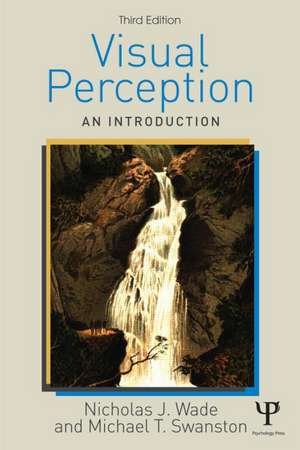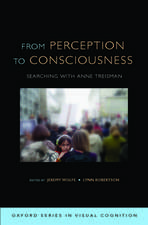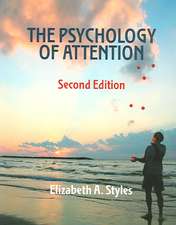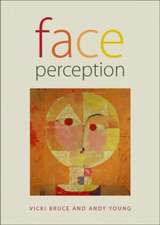Visual Perception: An Introduction, 3rd Edition
Autor Nicholas Wade, Mike Swanstonen Limba Engleză Paperback – 24 oct 2012
Vision is our most dominant sense. From the light that enters our eyes to the complex cognitive processes that follow, we derive most of our information about what things are, where they are, and how they move from our vision.
Visual Perception takes a refreshingly different approach to this enigmatic sense. From the function that vision serves for an active observer, to the history of visual perception itself the third edition has been extensively revised, updated and expanded, while still preserving the essential features of historical context, neurophysiology and independent thought that made the earlier editions so engaging.
Covering the perception of location, motion, object recognition and with up-to-date information on the workings of the visual brain, the 3rd edition looks at how our ideas have been shaped, not just by psychology, but by art, optics, biology and philosophy. The emphasis on understanding vision as a basis for action in the real world has also been expanded to cover seeing representations of all sorts, whether they are pictures or computer-generated displays.
The 3rd Edition of Visual Perception is a readable, accessible and truly relevant introduction to the world of perception and will be welcomed by students of visual perception as well as anyone with a general interest in the mysteries and wonder of vision.
| Toate formatele și edițiile | Preț | Express |
|---|---|---|
| Paperback (1) | 484.53 lei 6-8 săpt. | |
| Taylor & Francis – 24 oct 2012 | 484.53 lei 6-8 săpt. | |
| Hardback (1) | 1120.55 lei 6-8 săpt. | |
| Taylor & Francis – 24 oct 2012 | 1120.55 lei 6-8 săpt. |
Preț: 484.53 lei
Nou
Puncte Express: 727
Preț estimativ în valută:
92.73€ • 96.44$ • 77.60£
92.73€ • 96.44$ • 77.60£
Carte tipărită la comandă
Livrare economică 15-29 martie
Preluare comenzi: 021 569.72.76
Specificații
ISBN-13: 9781848720435
ISBN-10: 1848720432
Pagini: 336
Ilustrații: 146 b/w images, 10 halftones and 136 line drawings
Dimensiuni: 156 x 234 x 23 mm
Greutate: 0.5 kg
Ediția:1
Editura: Taylor & Francis
Colecția Psychology Press
Locul publicării:Oxford, United Kingdom
ISBN-10: 1848720432
Pagini: 336
Ilustrații: 146 b/w images, 10 halftones and 136 line drawings
Dimensiuni: 156 x 234 x 23 mm
Greutate: 0.5 kg
Ediția:1
Editura: Taylor & Francis
Colecția Psychology Press
Locul publicării:Oxford, United Kingdom
Cuprins
1. Understanding visual perception. 2. Fundamentals of vision. 3. Theoretical approaches to vision. 4. Optics and the eye. 5. The visual brain. 6. Spatial location. 7. Spatial motion. 8. Spatial Representation. 9. Summary and conclusions.
Notă biografică
Nicholas J. Wade is Emeritus Professor of Psychology at the University of Dundee. He studied at Edinburgh and Monash Universities and at the Max-Planck-Institute for Behavioural Physiology, Seewiesen, Germany. His research is concerned with binocular vision and motion perception, the history of vision research and the interplay between visual science and visual art.
Michael T. Swanston is Emeritus Professor of Psychology at the University of Abertay Dundee. He studied at Cambridge and Dundee Universities and held a Research Fellowship at the University of California Santa Barbara. His research is concerned with spatial representation and motion perception in vision and the perception and measurement of pain.
Michael T. Swanston is Emeritus Professor of Psychology at the University of Abertay Dundee. He studied at Cambridge and Dundee Universities and held a Research Fellowship at the University of California Santa Barbara. His research is concerned with spatial representation and motion perception in vision and the perception and measurement of pain.
Recenzii
"Wade and Swanston take a functional approach to visual perception, starting from everyday examples like crossing the road. Rather than covering the traditional topics (e.g., brightness, colour, size, shape, depth, motion, illusions) in the traditional way, the authors have chosen to focus on the functions of vision in a 3-D environment, particularly emphasizing the role of spatial relationships (both static and moving) and reference frames. This provides a unique perspective on visual perception. In addition, they take a historical approach because it is important to know what the major ideas are, to understand the arguments and where they are coming from rather than knowing only what the current fashions are. This choice, along with the enjoyable writing style and characteristic illustrations, provides a unique flavour to the book. If you want to make your students think more deeply about visual perception rather than merely being taken from one cool phenomenon to another, this book is strongly recommended." - Johan Wagemans, University of Leuven, Belgium
"I believe that the three texts in this sequence of books deserve the title of classics. It is hard to imagine how Wade’s and Swanston’s textbooks could be improved upon and for anyone who wishes to acquire detailed knowledge of visual perception, this latest edition provides an unbeatable source. In addition to the detailed text, this edition includes many of Wade’s intriguing illustrations: these are frequently manipulations of portraits of famous vision researchers drawn in complex ways to illustrate their scientific contributions: wonderfully stimulating." - Ian Gordon. University of Exeter
"I believe that the three texts in this sequence of books deserve the title of classics. It is hard to imagine how Wade’s and Swanston’s textbooks could be improved upon and for anyone who wishes to acquire detailed knowledge of visual perception, this latest edition provides an unbeatable source. In addition to the detailed text, this edition includes many of Wade’s intriguing illustrations: these are frequently manipulations of portraits of famous vision researchers drawn in complex ways to illustrate their scientific contributions: wonderfully stimulating." - Ian Gordon. University of Exeter
Descriere
Visual Perception takes a refreshingly different approach to this enigmatic sense. From the function that vision serves for an active observer, to the history of visual perception itself.




















